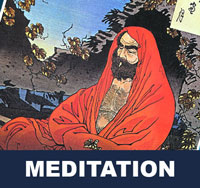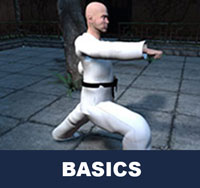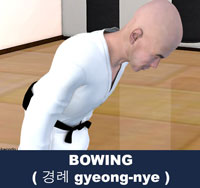Taekwondo 태권도Taekwondo Preschool
Promotion from one geup to the next can proceed rapidly in some schools, since schools often allow geup promotions every two, three, or four months. Students of geup rank learn the most basic techniques first, and then move on to more advanced techniques as they approach first dan. Many of the older and more traditional schools often take longer to allow students to test for higher ranks than newer, more contemporary schools, as they may not have the required testing intervals. View Taekwondo belt levels »

About Meditation
The term meditation refers to a broad variety of practices (much like the term sports) that includes techniques designed to promote relaxation, build internal energy or life force (qi, ki, prana, etc.) and develop compassion, love, patience, generosity and forgiveness.
Meditation is a practice in which an individual trains the mind or induces a mode of consciousness, either to realize some benefit or as an end in itself.
The term meditation refers to a broad variety of practices (much like the term sports) that includes techniques designed to promote relaxation, build internal energy or life force (qi, ki, prana, etc.) and develop compassion, love, patience, generosity and forgiveness. A particularly ambitious form of meditation aims at effortlessly sustained single-pointed concentration single-pointed analysis, meant to enable its practitioner to enjoy an indestructible sense of well-being while engaging in any life activity.

The word meditation carries different meanings in different contexts. Meditation has been practiced since antiquity as a component of numerous religious traditions and beliefs. Meditation often involves an internal effort to self-regulate the mind in some way. Meditation is often used to clear the mind and ease many health issues, such as high blood pressure, depression, and anxiety. It may be done sitting, or in an active way – for instance, Buddhist monks involve awareness in their day-to-day activities as a form of mind-training. Prayer beads or other ritual objects are commonly used during meditation in order to keep track of or remind the practitioner about some aspect of the training.
Meditation may involve generating an emotional state for the purpose of analyzing that state – such as anger, hatred, etc. – or cultivating particular mental response to various phenomena, such as compassion. The term "meditation" can refer to the state itself, as well as to practices or techniques employed to cultivate the state.
Meditation may also involve repeating a mantra and closing the eyes. The mantra is chosen based on its suitability to the individual meditator.
Meditation has a calming effect and directs awareness inward until pure awareness is achieved, described as being awake inside without being aware of anything except awareness itself. In brief, there are dozens of specific styles of meditation practice, and many different types of activity commonly referred to as meditative practices.

Related Articles
Meditation is a practice in which an individual trains the mind or induces a mode of consciousness. The practice has a calming effect and directs awareness inward until pure awareness is achieved, described as being awake inside without being aware of anything except awareness itself. Meditation is often used to clear the mind and ease many health issues, such as high blood pressure, depression, and anxiety. View Meditation »
- History of Mediation - the history is intimately bound up with the religious context within which it was practiced. Around the 6th to 5th centuries BCE, other forms of meditation developed in Taoist China and Buddhist India.
- Definition of Meditation - refers to practices that includes techniques designed to promote relaxation, build internal energy or life force and develop compassion, love, patience, generosity and forgiveness. A particularly ambitious form of meditation aims at effortlessly sustained single-pointed concentration single-pointed analysis, meant to enable its practitioner to enjoy an indestructible sense of well-being while engaging in any life activity.
- Mediation Postures - various meditative postures have been used in meditation such as sitting cross-legged, sitting on a chair, and standing postures. In taekwondo, one can meditate in several stances ( 서기 sogi ) including the Back Stance ( 뒷굽이 dwi-kubi ) and the Crane Stance ( 학다리서기 hakdari-sogi ). One should feel comfortable and rest in a simple and unstrained way.
- Qigong - practice of aligning body, breath, and mind for health, meditation, and martial arts training. With roots in Chinese medicine, philosophy, and martial arts, qigong is traditionally viewed as a practice to cultivate and balance Qi (chi) or what has been translated as life energy.

Taekwondo Basics
Here is where you can learn more about Taekwondo 태권도. Knowing the fundamental basics is very important for your learning path as you build your skills and knowledge. There are certain rules that need to be followed to show respect to the master ( 사범님 sabeomnim ), the instructors ( 교사님 gyosannim ), other practitioners and to the martial arts. They vary between schools but many have similar rules and guidelines. For more information View Taekwondo Basics »
There are five tenets defined in the International Taekwondo Federation (ITF) and several more in World Taekwondo (WT).
Perseverance ( 인내 in-nae ): "One will persevere time and time again until they have achieved a result which is adequate towards what one was trying to achieve." View Taekwondo Tenets »
RESOURCES
This article uses material from the Wikipedia article "Meditation", which is released under the Creative Commons Attribution-Share-Alike License 3.0.























